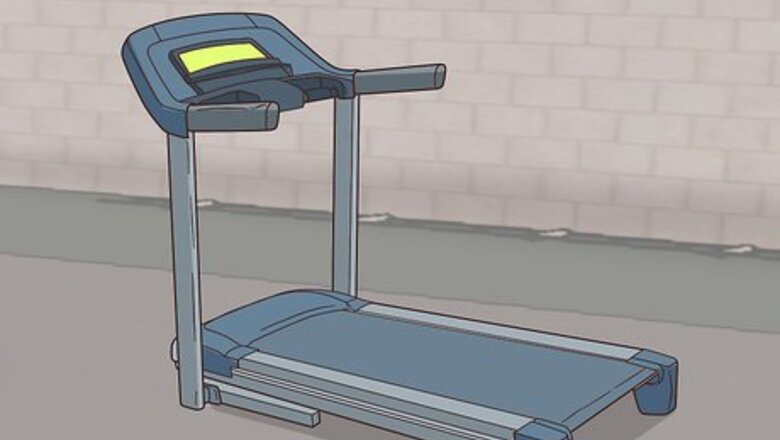
views
Running on a Treadmill
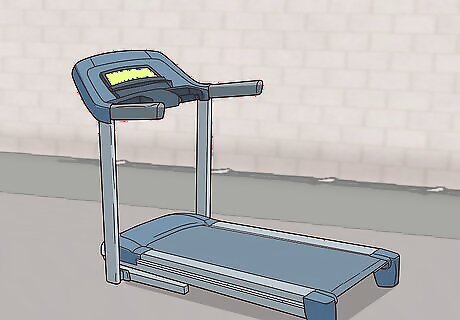
Take advantage of the benefits a treadmill can offer. With a treadmill, all you have to do is step on, press a few buttons, and get moving. They take up very little space, and, best of all, they’ll even keep tabs on your time, pace, overall distance, and physical stats like your heart rate throughout your workout. For many people, a treadmill is the most practical way to get a run in when space is at a premium. A treadmill can be a worthwhile investment if weather conditions or a lack of suitable outdoor spots in your area give you no choice but to run inside often. Many apartment complexes and condominiums make treadmills available to residents in their on-site fitness rooms, which can be helpful if you don’t have a gym membership.
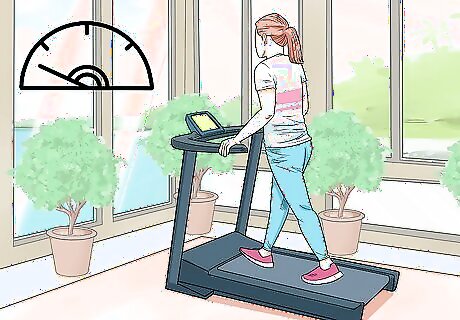
Warm up for 3-5 minutes. Start up the treadmill and begin walking at an easy pace to relax and loosen your cold muscles. A thorough warm up will leave you less vulnerable to potential injuries like torn ligaments and sprained ankles, which are just as common on the treadmill as they are on the road. Getting things off to a slow start will also give you time to familiarize yourself with the treadmill's various features and controls.

Increase your speed incrementally. Once you've got your heartrate up, bump the speed setting up a few notches to start going faster. Keep up a brisk jog for 2-3 minutes before finally settling into your preferred running speed. Raising your tempo a little at a time will help you get a feel for cadence and foot placement if you’re not used to running on a treadmill. To put your stamina to the test, make an effort to maintain your top speed for at least 15-30 minutes. Resist the urge to grip the handrails on either side of you while running. Taking hold of them will interfere with your technique, and could leave you prone to getting off your rhythm or losing your balance.
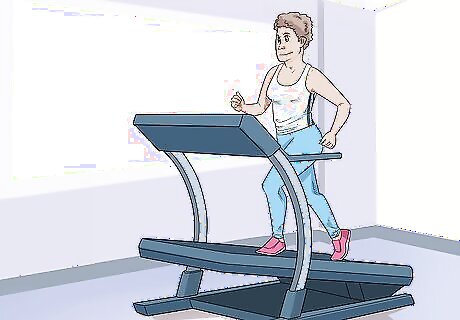
Change the angle of incline for more of a challenge. Increasing the treadmill’s elevation setting will make it feel like you’re running up a hill. A modest incline of 1-5% can offer experienced runners more of a challenge and keep things from becoming monotonous. Struggling up a steeper angle, meanwhile, can be a good way to build more strength in your legs or close out your workout. Keep in mind that the greater the angle of incline, the slower your pace will be. This may make it necessary to adjust your speed accordingly. Pushing yourself too hard while the treadmill is at a high elevation could present an increased risk of accident or injury.
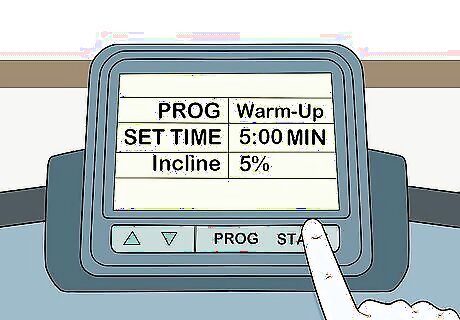
Try out different pre-programmed workouts. Many newer treadmills come loaded with fitness routines that automatically change up times and intensities for a more customizable run. One of these programs may make your workout more enjoyable if you find yourself bored of running at a constant speed. Sprint intervals, HIIT (high-intensity interval training) programs, and runs with built-in warmup and cooldown periods are just a few of the programs you might have at your disposal. Some treadmills even have advanced modes that continuously change up your speed and angle of incline to simulate outdoor running. EXPERT TIP Laila Ajani Laila Ajani Fitness Trainer Laila Ajani is a Fitness Trainer and founder of Push Personal Fitness, a personal training organization based in the San Francisco Bay Area. With over 10 years as a trainer and exercise specialist, Laila has expertise in competitive athletics (gymnastics, powerlifting, and tennis), personal training, distance running, and Olympic lifting. Laila is certified by the National Strength & Conditioning Association (NSCA), USA Powerlifting (USAPL), and she is a Corrective Exercise Specialist (CES). Laila Ajani Laila Ajani Fitness Trainer Find stimulating ways to make your treadmill workouts more engaging. Create a playlist of your favorite workout songs, watch a show or fitness class while you're on the machine, or try a dance routine from YouTube. If you're craving more variety, try dividing your cardio routine into 10-minute intervals on the treadmill, bike, rowing machine, and elliptical for a more enjoyable workout. It will be more fun than doing a full 40 minutes only on the treadmill.
Running in Place

Pick out a suitable spot. One of the biggest advantages of running in place is that it doesn’t require much space—in fact, you really only need to be able to take 1-2 steps in a single direction! Once you’ve found a satisfactory place to post up, clear the area of any nearby furniture or other objects to free up enough room to move comfortably. For maximum comfort and ease, choose a space that’s about one-and-a-half times as wide as your own body from shoulder to shoulder. An uncluttered garage, basement, workshop, or game room can work well for this purpose.
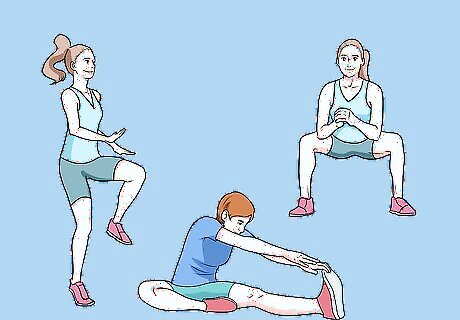
Warm up with a few active movements. Before you jump right into your workout, take a few minutes to loosen up your muscles and joints and get your blood pumping. A few rounds of high knees, deep lunges and dynamic stretches like swing kicks and hip rotations will help prepare your body for the more demanding activity to come. Your warmup should last at least 5-10 minutes, and target every part of your body you’ll be using during your run. An intelligent warmup routine will improve your performance and help prevent injury.

Focus on proper form. Running in place isn’t much different from running normally—simply root yourself in place and begin pumping your legs up and down. Land lightly on the balls of your feet with each step, and don’t forget to keep your arms moving to steady yourself, as well. Face forward and stay tall throughout your run. Try not to let your shoulders slouch or your head drop toward your chest. Even though you’re not covering any ground, it’s still important to be mindful of your form in order to avoid picking up bad habits.
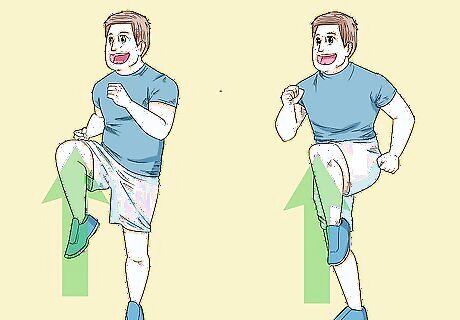
Switch up your pattern of movement. If you get tired of shuffling along in the same manner after a while, you can make things more interesting by modifying your technique to change direction. Take high, leaping steps every now and then like you’re attempting to clear a low obstacle, or bound from side to side as though you were running tires. Be careful not to get your feet crossed up while playing around with your footwork.

Increase your intensity. Take things up to the next level by increasing your speed or lifting your knees higher and higher with each step. You could also try pausing periodically to work in some squats, tuck jumps, or other bodyweight resistance exercises. Any variation that makes your run harder will give you more bang for your buck. Pick up a pair of light dumbbells to turn your run into a total-body workout. Just remember to take a break after a minute or 2 so that you don't strain your shoulder. Limit difficult movements to short bursts to avoid tiring yourself out too fast. For instance, you might run normally for 2-3 minutes, then break into a “sprint” for 30 seconds before returning to a normal pace.
Running Inside Your Home
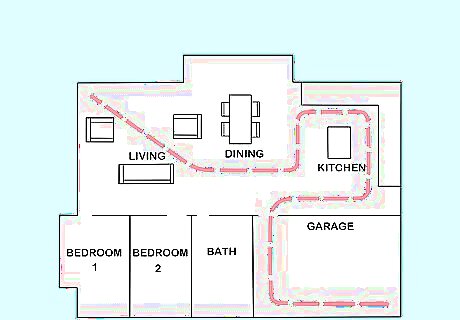
Map out a route through your home. Even if you don't have access to a treadmill and the idea of running in place doesn’t appeal to you, you can still get your daily jog in with a little imagination. Devise a course that allows you to move from room to room without stopping or turning around. You might start in the foyer, for instance, and make your way through the living room, kitchen, and adjoining hallways. Try racing up and down the front staircase to add a challenging all-terrain element to your run. Most modern homes have open floor plans, which can make it easier to plan out creative and interesting circuits.
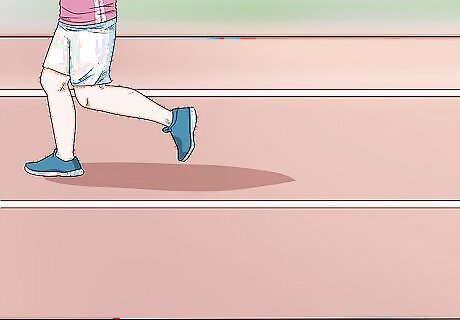
Find a surface that’s safe to run on. Whenever possible, stick to solid, stable flooring like wood, linoleum, or carpet. Whatever surface you go with should be clean, dry, and free of any obstacles or substances that might cause an inadvertent slip. It’s a good idea to pull back loose rugs for the same reason. Tread carefully on tile and concrete.

Wear a reliable pair of running shoes. You may be used to walking around the house barefoot, but accidents can happen if you try to run that way. Take your indoor run seriously—lace up your sneakers just like you would to hit the road, track, or trail. Shoes will offer better traction and support, which can be a major plus if you’re plodding along on an unfamiliar surface. Make sure the bottoms of your shoes are clean so you don’t track dirt all over the floor. Soft rubber soles may leave scuff marks on hardwood and linoleum surfaces. Consider buying a pair of minimalist running shoes to wear specifically for indoor jaunts.

Look out for furniture and other obstacles. No matter what sort of space you’re in, running indoors comes with the risk of collision. You’ll need to be sure-footed and actively moderate your speed to avoid careening into the wall or a piece of workout equipment. An unforeseen spill could result in injury or damage to your surroundings. Keep an eye out for your spouse, kids, roommate, pets, or anyone else that’s occupying your living space so you don’t bowl them over by accident. Be aware of where your knees, elbows, and other outlying parts of your body are at all times. It can be easy to get banged up if you’re not paying attention to what’s around you. Call out when you’re approaching a corner or blind doorway so other people will know you’re there.

Add variety to your workout. Try different types of exercises to help work different parts of your body while keeping your heart rate up. Add in sets of exercises like squats, jumping jacks, push-ups, and heel kicks. Try different sets each day to keep your routine interesting and effective.

Track your workouts for time rather than distance. Since you’ll be in such close quarters, you may find it all but impossible to keep up with how far you’ve traveled. Instead, start a timer at the beginning of your workout and stop it when you’re finished. 15-30 minutes should be long enough to elevate your heart rate and get your blood pumping. If you’re able to maintain a pace similar to the one you keep up outside, you can use it to figure out approximately how many miles you’ve ticked off. You could also strap on a pedometer to track your steps and give you a rough idea of how much distance you've put behind you.




















Comments
0 comment